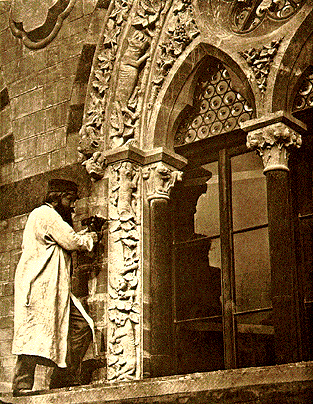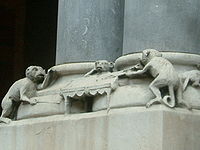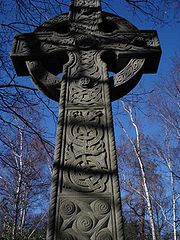
O'Shea and Whelan
Encyclopedia

Ballyhooly
Ballyhooly is a small village in North Cork situated along the N72 between Mallow and Fermoy.-External links:*...
in County Cork
County Cork
County Cork is a county in Ireland. It is located in the South-West Region and is also part of the province of Munster. It is named after the city of Cork . Cork County Council is the local authority for the county...
. They were notable for their involvement in Ruskinian
John Ruskin
John Ruskin was the leading English art critic of the Victorian era, also an art patron, draughtsman, watercolourist, a prominent social thinker and philanthropist. He wrote on subjects ranging from geology to architecture, myth to ornithology, literature to education, and botany to political...
gothic architecture
Gothic architecture
Gothic architecture is a style of architecture that flourished during the high and late medieval period. It evolved from Romanesque architecture and was succeeded by Renaissance architecture....
in the mid-19th century.
The practice comprised the brothers James and John O'Shea, along with their nephew Edward Whelan. James and John were the sons a craftsman who came to Cork to work on the construction of Convamore House, and who remained and set up a workshop in nearby Ballyhooly village. After his death the workshop was inherited by James and John, and is often referred to as "The O'Shea Brothers". However Whelan's role in the firm was equally significant. Nevertheless, James O'Shea was the most notable of the family. In addition to his work as an architectural mason he exhibited fine art sculptures in the classical style.

Trinity College, Dublin
Trinity College, Dublin , formally known as the College of the Holy and Undivided Trinity of Queen Elizabeth near Dublin, was founded in 1592 by letters patent from Queen Elizabeth I as the "mother of a university", Extracts from Letters Patent of Elizabeth I, 1592: "...we...found and...
and at the Kildare Street Club
Kildare Street Club
The Kildare Street Club was a gentlemen's club in Dublin, Ireland, at the heart of the Anglo-Irish Protestant Ascendancy.The Club remained in Kildare Street between 1782 and 1977, when it merged with the Dublin University Club...
, including the famous window piece showing the club members as monkeys playing billiards. At the time John Ruskin
John Ruskin
John Ruskin was the leading English art critic of the Victorian era, also an art patron, draughtsman, watercolourist, a prominent social thinker and philanthropist. He wrote on subjects ranging from geology to architecture, myth to ornithology, literature to education, and botany to political...
was seeking to revive lively freehand stone carving of the kind typical of medieval Gothic architecture. The architects Thomas Newenham Deane
Thomas Newenham Deane
Sir Thomas Newenham Deane was an Irish architect, the son of Sir Thomas Deane, and father of Sir Thomas Manly Deane, who were also architects....
and Benjamin Woodward
Benjamin Woodward
Benjamin Woodward was an Irish architect who, in partnership with Sir Thomas Newenham Deane, designed a number of buildings in Dublin....
were proposing to work with Ruskin on the design of the new Oxford University Museum of Natural History
Oxford University Museum of Natural History
The Oxford University Museum of Natural History, sometimes known simply as the Oxford University Museum, is a museum displaying many of the University of Oxford's natural history specimens, located on Parks Road in Oxford, England. It also contains a lecture theatre which is used by the...
. Woodward, who had worked with them in Dublin, brought in the O'Sheas as the best qualified carvers for the job. The O'Sheas worked in tandem with Ruskin and the architects to produce a series of elaborate carvings of plant and animal forms. Each was a unique and individual design.

Further problems arose when the Congregation of the university refused to pay for more carvings, which had largely been funded by public subscriptions. When the O'Sheas offered to work without pay, some members of the Congregation accused them of "defacing" the building with unauthorised work. According to Henry Acland, the professor who liaised with Ruskin, James O'Shea proceeded to carve caricatures of the congregation on the entrance of the building in the form of parrots and owls. Acland forced him to remove the heads, which remain defaced to this day.
The O'Sheas also worked on several other projects. One of the O'Sheas carved statues for St Mary's church in Rhyl, Wales. One also worked for the architect J.F. Bentley
John Francis Bentley
John Francis Bentley was an English ecclesiastical architect whose most famous work is the Westminster Cathedral in London, England, built in a style heavily influenced by Byzantine architecture....
, who described his attitude as "unbearable". Thomas Deane later employed Whelan to work in Oxford on the Meadow Buildings and at the Fleet Street Crown Life Office.
Thomas Woolner
Thomas Woolner
Thomas Woolner RA was an English sculptor and poet who was one of the founder-members of the Pre-Raphaelite Brotherhood. He was the only sculptor among the original members....
, a sculptor also involved in the Oxford project, employed James O'Shea to create carvings for his home. The O'Sheas and Whelan went on to work with Woolner and the architect Alfred Waterhouse
Alfred Waterhouse
Alfred Waterhouse was a British architect, particularly associated with the Victorian Gothic Revival architecture. He is perhaps best known for his design for the Natural History Museum in London, and Manchester Town Hall, although he also built a wide variety of other buildings throughout the...
in the design of the Manchester assize courts
Manchester assize courts
The Manchester Assize Courts were law courts once located on Great Ducie Street in Strangeways, Manchester in England. From 1864 to 1877, the 85 metre building was the tallest in Manchester before being overtaken by the Manchester Town Hall...
, producing a series of capitals depicting gruesome forms of punishment in history. Though the original building was demolished following bomb damage in World War Two, the carvings survive in the replacement building.
James O'Shea returned to Ireland to work in Callan as a monumental sculptor, specialising in Celtic crosses and establishing a new firm with his son Edward. A fine example of this work is the celtic cross in memory of the children's author Talbot Baines Reed
Talbot Baines Reed
Talbot Baines Reed was an English writer of boys' fiction who established a genre of school stories that endured into the second half of the 20th century. Among his best-known work is The Fifth Form at St. Dominic's. He was a regular and prolific contributor to The Boy's Own Paper , in which most...
, which stands at Abney Park Cemetery
Abney Park Cemetery
Abney Park in Stoke Newington, in the London Borough of Hackney, is a historic parkland originally laid out in the early 18th century by Lady Mary Abney and Dr. Isaac Watts, and the neighbouring Hartopp family. In 1840 it became a non-denominational garden cemetery, semi-public park arboretum, and...
in Stoke Newington
Stoke Newington
Stoke Newington is a district in the London Borough of Hackney. It is north-east of Charing Cross.-Boundaries:In modern terms, Stoke Newington can be roughly defined by the N16 postcode area . Its southern boundary with Dalston is quite ill-defined too...
, London
London
London is the capital city of :England and the :United Kingdom, the largest metropolitan area in the United Kingdom, and the largest urban zone in the European Union by most measures. Located on the River Thames, London has been a major settlement for two millennia, its history going back to its...
.

